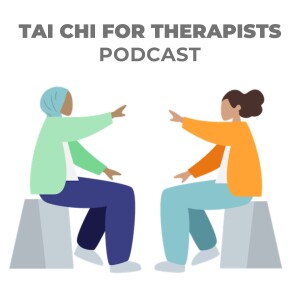In this episode we talk with Richard Leigh, a physiotherapist based in a small rural practice in Shaftesbury, Dorset, in the UK.
Richard implements tai chi and qigong movements into his private practice with a diverse range of patients.
Interview Summary
Clinical Integration Benefits:
- Complements existing physiotherapy approaches
- Provides better compliance compared to traditional exercises
- Can be incorporated into both individual treatment and group classes
- Particularly effective for complex cases with multiple pathologies
- Offers a holistic approach that addresses both physical and psychological aspects
Specific Clinical Applications:
Neurodynamics
Can prove more effective than traditional nerve stretches due to:
- Three-dimensional movement patterns
- Integration of breathing
- More flowing, less traumatic on nerves
- Better compliance than standard nerve tension exercises
Postural Control & Fall Prevention:
- Improves base of support
- Enhances midfoot balance
- Develops better spatial awareness
- Particularly beneficial for stair navigation in elderly patients
Breathing exercises:
- Helps mobilize shoulder joints
- Improves rotator cuff function
- Releases upper rib tension
- Benefits neurovascular bundles
Eight Brocades sequence:
- Can be introduced gradually (2 movements at a time)
- Works on multiple fascial lines
- Highly accepted by patients
- Can be modified for different ability levels
Safety Considerations:
- Very low risk compared to traditional exercises
- Suitable for elderly patients (including those in their 80s)
- Can be modified for seated practice
- Less likely to aggravate existing conditions compared to some traditional exercises
Improved outcomes for:
- Vestibular conditions
- Chronic pain
- Post-cancer rehabilitation
- Anxiety and depression
- Chronic stress
- Complex musculoskeletal conditions
Implementation Tips:
- Start with simple movements and progress gradually
- Can be taught in both individual and group settings
- Class sizes of 8-15 people are manageable
- Regular practice (weekly classes) shows good results
- Consider incorporating into existing treatment programs
Patient Compliance Benefits:
- Higher engagement than traditional exercise programs
- Patients report enjoying the movements
- Can be practiced at home independently
- Promotes self-efficacy and autonomy
- Empowers patients in their recovery journey
In Summary
Richard demonstrates how Tai Chi and Qigong can prove valuable additions to his toolkit, offering safe, effective, and well-received interventions that complement traditional approaches while promoting patient self-management and compliance.
Listen, rate, and subscribe.
Have you enjoyed this episode? Then you may like to rate and subscribe so that you can enjoy more podcasts as we release them.
Would you like to find out more about our class leading CPD course for health professionals: Tai Chi for Therapists.
We created this course for all registered allied health professionals, clinicians, and other rehabilitation professionals who would like to learn how to implement evidence-based tai chi and qigong movements into their clinical practice.
If you’re a physiotherapist, physical therapist, occupational therapist, occupational or physiotherapy assistant, or other allied health professional visit our course page to find out more.
We look forward to seeing you,
Phil & Helen
Website: www.taichifortherapists.com

No comments yet. Be the first to say something!